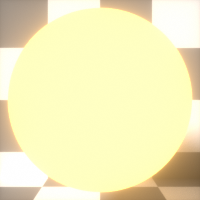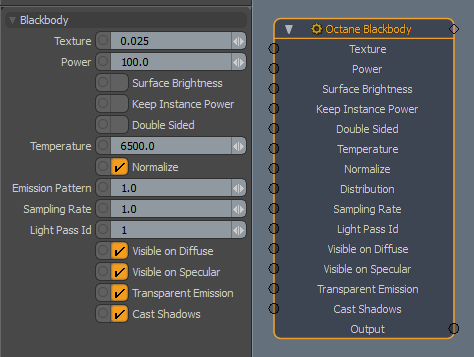
The Black BodyAn opaque object that emits thermal radiation. In Octane, this is used to designate illumination properties for mesh emitters. emission uses Temperature (in Kelvin) and Power to control the color and intensity of the light.


Texture - Sets the light source's efficiency to either a value or texture. Keep in mind that real-world lights aren't 100% efficient at delivering power at their specified wattage. A 100 watt light bulb doesn't deliver 100 watts of light.
Power - The light source's wattage. You should set each light to their real-world wattage. For example, set a desk lamp to 25 watts, a ceiling lamp to 100 watts, and an LED light to 0.25 watts.
Surface Brightness - Causes emitters to keep a constant Surface Brightness, independent of the emitter's surface area.
Keep Instance Power - Enabling this option with Surface Brightness disabled, allows the power of uniformly scaled objects to remain constant.
Double Sided - Allows emitters to emit light from the front and back sides.
Temperature - The temperature (in Kelvin) of the Black Body emission's light.
Normalize - This keeps the emitted light's luminance constant if the temperature varies.
Distribution - Controls the light pattern. You can set this to a Greyscale image connected to a texture or IESAn IES light is the lighting information representing the real-world lighting values for specific light fixtures. For more information, visit http://www.ies.org/lighting/. file. The Image texture's Projection nodes control the light's orientation and direction.
Sampling Rate - This lets you choose which light sources receive more samples. A value of 0 means this light source is not sampled directly.
Light Pass ID - The Light Pass ID which captures the emitter's contribution. Used by Render PassesRender passes allow a rendered frame to be further broken down beyond the capabilities of Render Layers. Render Passes vary among render engines but typically they allow an image to be separated into its fundamental visual components such as diffuse, ambient, specular, etc.. and Light Linking.
Visible On DiffuseAmount of diffusion, or the reflection of light photons at different angles from an uneven or granular surface. Used for dull, non-reflecting materials or mesh emitters. - When enabled, the light source casts light and shadows onto diffuse surfaces.
Visible On SpecularAmount of specular reflection, or the mirror-like reflection of light photons at the same angle. Used for transparent materials such as glass and water. - When enabled, the light source will be visible on specular surfaces.
Transparent Emission - Cast illumination on diffuse objects, even if the emitter is transparent.
Cast Shadows - When enabled, direct light shadows will be calculated for this light source. The Sampling Rate must be greater than 0 for this option to work.